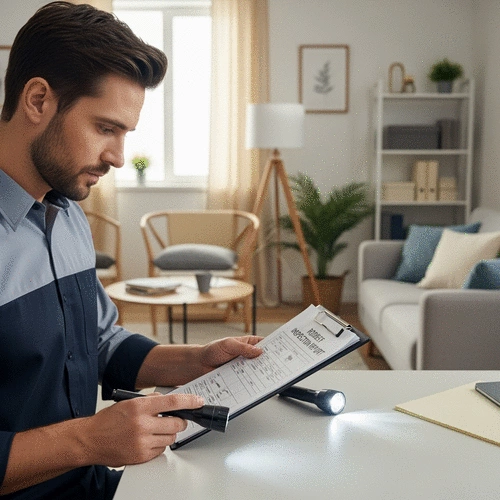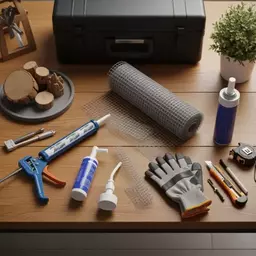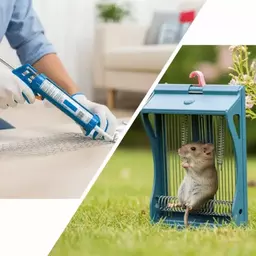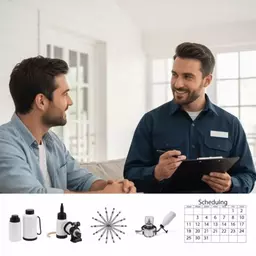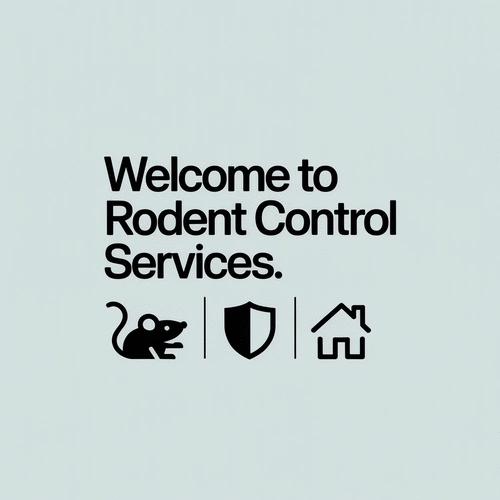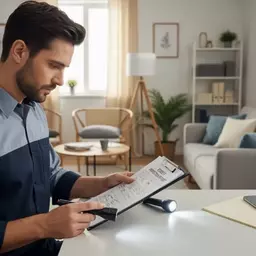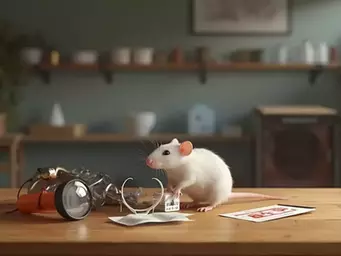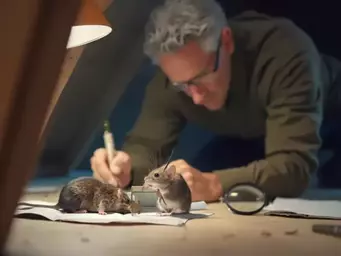Have you ever noticed signs of rodents in your space but weren't sure what to do next? Understanding the inspection process can empower you to take control and maintain a safe, healthy environment.
What You Will Learn
- The importance of professional rodent inspections for identifying infestation signs.
- Key areas inspectors focus on during an inspection, including entry points and food sources.
- Common signs of rodent activity such as droppings, nests, and gnaw marks.
- Health risks associated with rodent infestations and the need for timely inspections.
- Essential steps to prepare your home for a rodent inspection for a smoother process.
- An overview of potential costs and timeframes involved in rodent inspections.
- Proven pest management strategies following inspections to prevent future infestations.
Understanding the Rodent Inspection Process
This visual outlines the typical steps involved in a professional rodent inspection, from preparation to post-inspection strategies, highlighting key durations and cost estimates.
Step 1 Preparing for Inspection
- ✓ Clear clutter & access points
- ✓ Secure pets in a safe area
- ✓ Notify inspector of concerns
Step 2 During the Inspection
- ● Examine entry points (windows, pipes)
- ● Look for droppings, nests, gnaw marks
- ● Assess food sources & environmental conditions
- ● Identify potential health risks
Step 3 Inspection Time & Cost
- ⏱ Duration: 30 minutes to 1 hour
- $ Average Cost: $75 to $150
- ⓘ Varies by location & property size
Step 4 Pest Management Strategies
- ✓ Seal identified entry points
- ✓ Implement traps or bait stations
- ✓ Tailored plan for effective control
Understanding Professional Rodent Inspections: What They Involve
When it comes to keeping your space free from unwanted guests, professional rodent inspections play a crucial role. During an inspection, trained experts carefully assess your property for signs of rodent infestation. They look for entry points, droppings, gnaw marks, and other indicators that rodents may be present. Typically, inspections can take anywhere from 30 minutes to a few hours, depending on the size of the area and the complexity of the property.
The process begins with a thorough visual examination of both the interior and exterior of your property. Inspectors will check common hotspots like basements, attics, and utility areas. Their goal is to identify potential hazards and gather as much information as possible to develop an effective management plan.
What Happens During a Rodent Inspection?
During a rodent inspection, the inspector focuses on several key areas:
- Entry Points: Inspectors examine windows, doors, and any gaps around pipes and vents for potential access points. For detailed guidance on preventing rodent entry, refer to the NPS Rodent Exclusion Manual.
- Signs of Activity: Look for droppings, nests, and any signs of gnawing on materials.
- Food Sources: Inspectors assess your pantry and food storage areas to identify places that might attract rodents.
- Environmental Conditions: They evaluate outside conditions like overgrown vegetation and clutter that may harbor rodents.
By systematically checking these areas, inspectors gather vital information about the extent of the problem and the best way to address it. This attention to detail ensures a comprehensive assessment, setting the stage for effective pest management.
Key Insights on Rodent Behavior and Habitat
Understanding the behavior and habitat of common rodent species is essential for effective control. Mice and rats are the most prevalent, with each exhibiting unique habits. For instance, house mice tend to prefer warm, sheltered environments, often nesting in walls or behind appliances, while rats are more likely to burrow outside and venture indoors for food.
Some key signs of a rodent infestation include:
- Droppings: Small dark pellets found near food sources or nesting areas.
- Gnaw Marks: Visible chewing on wood, wires, or plastic materials.
- Footprints: Tiny tracks in dust or dirt, indicating movement.
Recognizing these signs early can help mitigate a larger infestation. As a pest management expert, I often advise homeowners to regularly inspect their properties for these indicators.
Health Risks Associated with Rodent Infestations
Rodents are not just nuisances; they can pose serious health risks to humans. They are known carriers of diseases such as hantavirus, leptospirosis, and salmonella. Their droppings and urine can contaminate food sources, leading to potential health issues for you and your family. The Centers for Disease Control and Prevention (CDC) provides extensive information on diseases carried by rodents.
Timely inspections are crucial in minimizing these risks. By addressing a rodent problem early on, you can protect both your health and your living environment. Ensuring that your property is rodent-free is part of maintaining a safe and healthy space.
Common Signs of Rodent Infestation to Watch For
Being proactive is key to effective rodent control! Here are some common signs that might indicate a rodent infestation:
- Droppings: Often found in kitchens, food storage areas, and along walls.
- Nests: Made of shredded paper, fabric, or insulation material, usually found in hidden areas.
- Gnaw Marks: Look for damage on furniture, walls, and food packaging.
- Noises: Scratching or scurrying sounds, especially at night when rodents are most active.
If you notice any of these signs, it’s important to take action quickly. Ignoring the issue can lead to a full-blown infestation, which can be more challenging and costly to resolve.
Pest Management Strategies Post-Inspection
Once the inspection is complete, the next steps involve implementing effective pest management strategies. This may include sealing entry points, setting traps, or utilizing bait stations. A professional pest control service, like Rodent Control Services, will tailor a plan based on the inspection findings and the specific needs of your property. For further information on identifying and preventing rodent infestations, consult resources from the Environmental Protection Agency (EPA).
It's essential to follow through with these strategies to ensure a rodent-free environment. Remember, the goal is not just to remove existing rodents but to prevent future infestations. A proactive approach can save you time, money, and stress in the long run!
Pro Tip
To maximize the effectiveness of your rodent inspection, consider conducting a pre-inspection walk-through. Before the professionals arrive, take note of any unusual sightings, droppings, or noises you've experienced. This information can help the inspector focus on the right areas, ensuring a more efficient and thorough assessment of your property.
Preparing for Your Rodent Inspection: Essential Steps
How to Get Ready for an Inspection
Getting ready for a rodent inspection is a crucial step in ensuring a smooth process. Before the experts arrive, it's important to prepare your home. Start by clearing areas around potential entry points and nesting sites. This means removing clutter, such as boxes, furniture, or any items that might obstruct the inspector's view.
Additionally, make sure to secure any pets during the inspection. Furry friends can add extra chaos, and it’s best to have them in a safe, quiet space away from the action. After all, we want to keep your pets safe and minimize distractions for the inspector!
- Clear clutter around entry points and nesting sites.
- Secure pets in a safe area away from the inspection.
- Notify the inspector of any previous rodent sightings or concerns.
These simple steps ensure that the inspection goes smoothly and that our team can focus on identifying any potential issues in your space.
What to Expect: Timeframes and Costs
When it comes to rodent inspections, understanding the timeframes and costs involved is key. Typically, a standard rodent inspection can take anywhere from 30 minutes to an hour, depending on the size of your property and the extent of the inspection.
As for costs, they can vary widely based on several factors, including your location, the size of the area being inspected, and any additional services you may need. On average, inspections range from $75 to $150, but it's essential to get a quote tailored to your specific situation.
- Inspection Duration: 30 minutes to 1 hour.
- Average Cost: $75 to $150 (depends on various factors).
- Additional services may incur extra costs.
By knowing these details, you can better prepare for the financial aspect and time commitment of your rodent inspection.
Inspection Checklist: What Inspectors Look For
To give you a clearer picture of what happens during a rodent inspection, here’s a detailed checklist of items and areas that inspectors evaluate:
- Entry points: doors, windows, and vents.
- Signs of activity: droppings, gnaw marks, and urine stains.
- Nesting locations: attics, basements, and behind appliances.
- Structural integrity: looking for holes and cracks in walls and foundations.
- Food sources: uncovering any easy access to food that might attract rodents.
This checklist not only helps you understand what our team will be looking for but also empowers you to address potential issues proactively. Remember, the more prepared you are, the easier it is for us to help make your home rodent-free!
Frequently Asked Questions About Rodent Inspections
What is a professional rodent inspection?
A professional rodent inspection involves trained experts assessing your property for signs of rodent infestation, identifying entry points, activity signs (like droppings and gnaw marks), food sources, and environmental conditions that attract rodents.
How long does a typical rodent inspection take?
A standard rodent inspection usually takes anywhere from 30 minutes to an hour, though this can vary based on the property size and the complexity of the inspection.
What are the common signs of a rodent infestation?
Key signs include droppings (small, dark pellets), gnaw marks on wood or wires, nests made of shredded materials, and scratching or scurrying noises, especially at night.
What health risks are associated with rodents?
Rodents can carry serious diseases such as hantavirus, leptospirosis, and salmonella, which can be transmitted through their droppings, urine, or bites, contaminating food and surfaces.
How much does a rodent inspection cost?
On average, rodent inspections can range from $75 to $150, but costs can vary depending on your location, the size of your property, and the specific services required.
What should I do to prepare for a rodent inspection?
Before an inspection, clear clutter around potential entry points and nesting areas, secure pets in a safe and quiet space, and inform the inspector of any previous rodent sightings or concerns you may have.
What happens after a rodent inspection?
Following an inspection, a pest management plan will be developed. This often includes sealing entry points, setting traps or bait stations, and implementing strategies tailored to prevent future infestations.
Recap of Key Points
Here is a quick recap of the important points discussed in the article:
- Thorough Inspections: Regular professional rodent inspections are essential for identifying entry points, signs of activity, and potential hazards.
- Signs of Infestation: Look for droppings, gnaw marks, nests, and noises, especially at night, as early indicators of rodent presence.
- Health Risks: Rodents carry diseases that can contaminate food sources, making timely inspections crucial to protect health.
- Preparation Steps: Clear clutter around entry points, secure pets, and inform inspectors of any past rodent sightings to facilitate a smooth inspection.
- Pest Management Strategies: Implement effective strategies post-inspection, such as sealing entry points and setting traps, to prevent future infestations.

